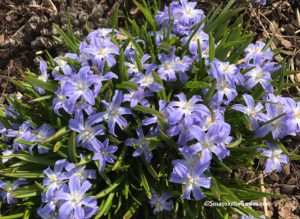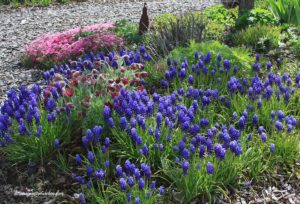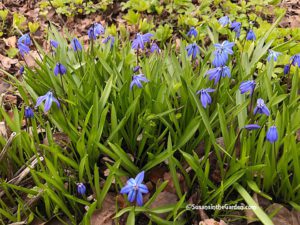April 15 Column: Spring Bulbs

How many of you are yearning for some color in your garden right now? If you live in a temperate area of the country like I do, you’re just as anxious as I am. One of the things I’m slowly starting to see in my garden is spring bulbs. They are a sight for sore eyes, let me tell you!
Spring bulbs are the topic of this week’s garden column. Here is a link to it in today’s edition of The Spokesman-Review: Spring-blooming bulbs brighten up the garden. In it, I talk about caring for them while they’re growing and after they’ve bloomed. (or you can read my column lower in this post)
I also mention some of the smaller, specialty bulbs. There are a few photos of examples of them at the bottom of this post. Remember that you can click on any of the photos to view a larger image.
This topic of this week’s “Everyone Can Grow A Garden” video is soil preparation. I know we’re all very anxious to start planting. For this region, at least, the temperatures are still too chilly and the soil is too wet. No matter where you live, I hope my quick tips will help get your garden off to a great start. Here’s the video:
Here are a few of the smaller specialty bulbs mentioned in my column. The first are Chionodoxa or glory of the snow:


These are the popular grape hyacinths. In addition to the popular purplish-blue ones, you can find ones with white or bicolor blossoms.

These little charmers are Siberian Squill (Scilla siberica). The intense blue of their flowers is stunning!
Spring Bulbs garden column:
by Susan Mulvihill
As spring unfolds in my garden, I’m treated to dozens of delightful surprises in the form of spring-blooming bulbs. These flowers are my reward for making it through what has seemed like the longest winter of my life.
It’s easy to forget where these plants will appear. That’s due to the large numbers of perennials and shrubs that are visible for months at a time. Slowly but surely, the blossoms of crocuses, grape hyacinths, daffodils, narcissus, tulips and alliums will shout “hey, look at me!”
This parade of bright colors wouldn’t happen if I hadn’t given in to the bulb catalogs’ offerings over the years.
A few years ago, I began an urgent search for Muvota tulips. I saw them blooming in a display garden at the Northwest Flower & Garden Show. The flowers are stunning with their deep-red petals bordered by bright orange. I finally located the bulbs at a local garden center last fall and triumphantly added them to a flower bed. So far, the bulbs’ leaves have emerged and I’m anxiously awaiting a dazzling floral show.
If your garden is lacking some springtime colors in your garden, study your flower beds over the next month. Look for empty gaps. Before you forget where those spots are, mark them with a stake. Since bulb-planting season is in the fall, you’ll be ready to shop for bulbs as soon as they’re available.
Don’t worry about having a gap after the bulbs bloom next spring, however. Those that require deep planting — tulips, narcissus and daffodils, for example — can be over-planted with annuals after the danger of frost has passed. The annuals’ roots won’t interfere with the bulbs below.
Even if you only have a little room in your flower beds, there’s a bulb for every spot. In addition to the more common types, plenty of equally-appealing smaller bulbs are available. Consider planting glory-of-the-snow, Siberian squill, Spanish bluebells, fritillaries and snowdrops; all are hardy for this region. Over time, the bulbs will multiply which creates a more natural look.
Spring-flowering bulbs don’t require much care while they’re growing. One area I have to admit being lax about is feeding my established bulbs on an annual basis. I tend to just let them do their own thing, without stopping to think about the energy they require to produce their knock-out blooms year after year.
A colleague of mine, Ed Hume, recommends feeding them with a liquid fertilizer — my favorite is diluted fish emulsion — when the new leaves are a few inches tall, and then again when the blooms are fading.
After bulbs have finished flowering, it’s tempting to yank up the foliage before it starts turning brown. However, that’s not a great idea because those leaves put energy into the bulbs for the following year’s bloom.
Fortunately, Hume has sage advice on this topic as well. He once told me that research has shown it’s safe to remove the leaves of tulips, daffodils and hyacinths 21 days after they bloom. He feels the leaves of other bulbs should be left in place for six to eight weeks — a worthwhile practice that can try the patience of tidy gardeners like myself.
No matter which types of bulbs catch your fancy, don’t forget to plant some spring-bloomers as your early-season reward next year.

